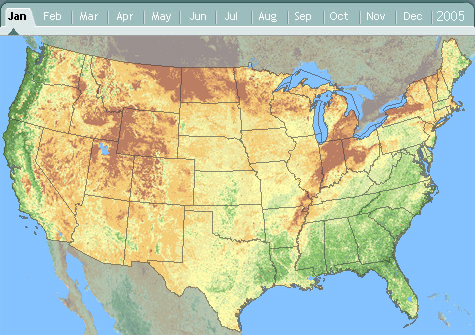| These Advanced Very High Resolution Radiometer (AVHRR)
images are collected by the National
Oceanic and Atmospheric Agency's polar-orbiting Television Infrared
Observation Satellites (NOAA-11 and NOAA-12). The images have been received,
processed, and distributed by the U.S.
Geological Survey since 1987. The spatial or ground resolution of
the AVHRR data is 1.1 kilometers. The AVHRR sensor acquires data in a
wide swath (approximately 2,400 kilometers), enabling it to create an
image of the entire surface of the Earth each day. The NOAA-12 satellite
acquires data in early morning and the NOAA-11 satellite in early afternoon.
Because the AVHRR sensor observes all of the Earth's surface each day,
the likelihood that one or more cloud-free observation of the surface
(over a period of days) is increased. When all of the observations (images)
for a month are combined, using a selection criteria that selects clear
sky observations, nearly cloud free images can be created.
A vegetation index (the Normalized-Difference Vegetation Index) is calculated
from to these images, which represents the quantity and vigor (photosynthesis
activity) of the vegetation. The equation for the vegetation index makes
it relatively easy to distinguish green vegetation from non-vegetated
areas such as water, barren land, ice, snow, and clouds.
With this ability, changes in surface processes over short periods, such
as growing seasons, can be monitored. |


